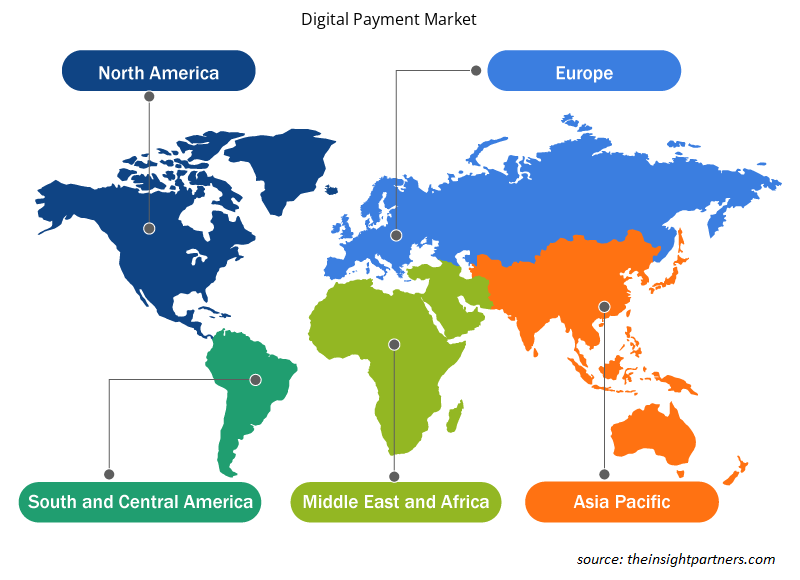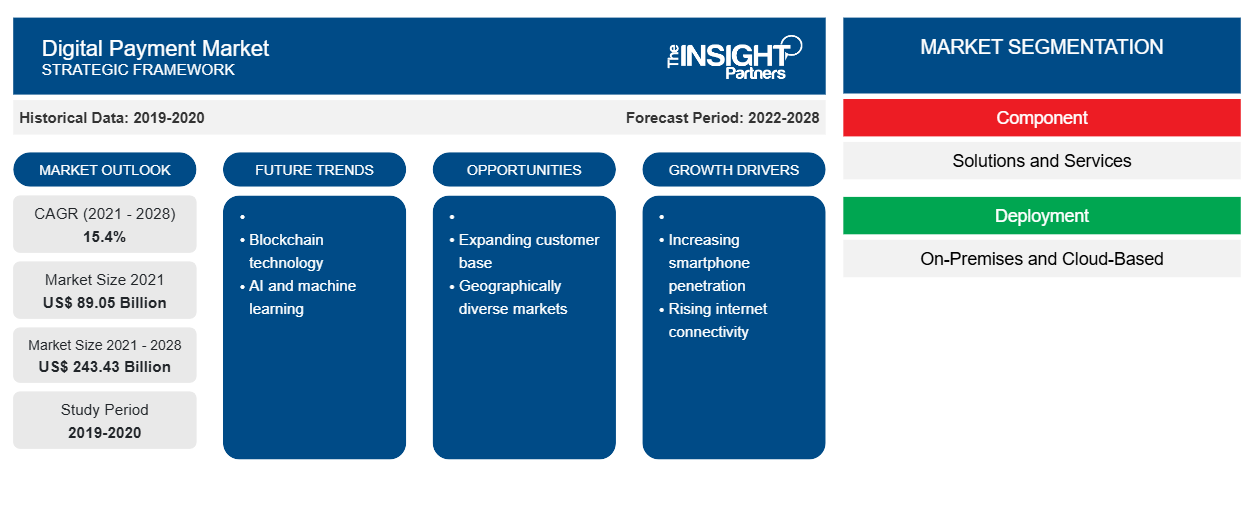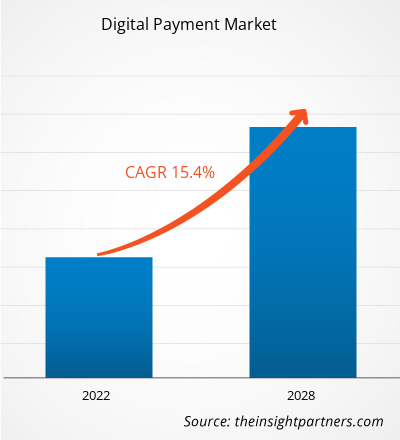디지털 결제 시장은 2021년 890억 4,567만 달러에서 2028년 2,434억 2,671만 달러로 성장할 것으로 예상되며, 2021년에서 2028년까지 연평균 성장률 15.4%로 성장할 것으로 추산됩니다.
글로벌 디지털 결제 시장은 스마트폰의 보급이 확대되어 mCommerce가 확대됨에 따라 예측 기간 동안 성장할 것으로 예상됩니다. 사람들이 인터넷에 접속하는 방식은 모바일 커머스 의 성장에 직접적인 영향을 미칩니다 . 사용자는 스마트폰이 더 저렴하고 고속 인터넷이 더 이상 많은 국가에서 프리미엄 인프라가 아니기 때문에 인터넷 서핑을 위해 PC보다 스마트폰을 선호합니다. 소매업체는 탐색하기 쉬운 카탈로그와 간단한 결제 환경을 갖춘 쇼핑 애플리케이션을 개발합니다. 고객이 본질적으로 모바일 폰에 묶여 있다는 사실은 은행원과 결제 서비스 제공업체가 간과하지 않습니다. 은행은 모바일 기기 화면에서 거래를 완료할 수 있는 뱅킹 앱을 제공합니다. 모바일 커머스는 또한 특히 무현금 결제를 수락하는 측면에서 오프라인 비즈니스의 업무 방식을 바꾸었습니다. 더욱이 물리적 상거래와 디지털 상거래의 차이가 사라지고 있으며 채널이 점점 더 융합되고 있습니다. COVID-19 팬데믹 동안 비접촉 결제에 대한 강조로 인해 매장 내 구매 경험이 온라인에 상당히 가까워졌습니다. 또한, 팬데믹 이전에도 일부 지역에서는 비접촉 결제가 이미 잘 확립되어 있었습니다. 비접촉 결제 및/또는 생체 인식은 온라인 구매 경험에서 널리 퍼져 있습니다. 비접촉 카드는 가장 널리 퍼진 비접촉 결제 유형입니다. 반면 모바일 결제는 사용하기 쉽고 소매 결제 방법으로 OEM(Original Equipment Manufacturer) Pay 솔루션의 인기가 높아져 인기를 얻고 있습니다. 일부 국가에서는 소매업체와 정부가 고객에게 비접촉 결제를 늘리고 소매업체가 이를 가능하게 하도록 적극적으로 요청합니다. 많은 은행이 판매 시점에서 터치패드나 현금의 필요성을 줄이기 위해 비접촉 결제 한도를 늘렸습니다. 이러한 모든 요소가 디지털 결제 시장의 성장을 촉진합니다.
귀하의 요구 사항에 맞게 이 보고서를 사용자 정의하세요
이 보고서의 일부 또는 국가 수준 분석, Excel 데이터 팩을 포함하여 모든 보고서에 대한 사용자 정의를 무료로 받을 수 있으며 신생 기업 및 대학을 위한 훌륭한 혜택과 할인 혜택을 이용할 수 있습니다.
- 이 보고서의 주요 시장 동향을 알아보세요.이 무료 샘플에는 시장 동향부터 추정 및 예측까지 다양한 데이터 분석이 포함됩니다.
COVID-19 팬데믹이 디지털 결제 시장에 미치는 영향
COVID-19 팬데믹은 디지털 결제 시장에 도움이 되었습니다. 기업들은 팬데믹과 원격 근무 환경의 발전으로 인해 새로운 어려움에 직면하고 있습니다. 세계은행이 팬데믹에 대한 정책 대응을 조사한 결과, 개발도상국의 최소 58개 정부가 COVID-19에 대한 지원을 제공하기 위해 디지털 결제를 채택했습니다. 최소 36개국이 현금 인출 외에도 저축이나 거래에 사용할 수 있는 완전한 기능의 계좌로 자금을 받았습니다. 금융 포용에는 이러한 광범위한 역량이 필요합니다. 또한 2020년 팬데믹의 출현으로 글로벌 시장 운영에 많은 어려움이 발생했습니다. COVID-19 사례가 증가하면서 선진국의 의료 인프라가 붕괴되었습니다. 그 결과, 공공 의료 비상사태로 인해 정부와 시장 참여자가 개입하여 예측 기간 동안 손실을 회복하기 위한 연구 개발 이니셔티브의 협력적 노력을 통해 시장 운영과 수익을 회복하도록 지원해야 합니다. 또한 투자 증가는 향후 몇 년 동안 디지털 결제 시장에 좋은 징조입니다.
디지털 결제 시장 통찰력
오픈 뱅킹 API 채택 증가
금융 서비스 회사는 오픈 뱅킹 이니셔티브와 애플리케이션 프로그래밍 인터페이스 의 중요성을 인식하고 있습니다 . 기존 은행은 이 부문에서 경쟁하고 우수한 제안과 서비스를 제공하는 신규 진입자에게 중개되지 않으려면 디지털 역량을 향상시켜야 한다는 것을 알고 있습니다. 예를 들어 PayPal, Wells Fargo, Visa와 같은 수많은 금융 서비스 회사는 오픈 뱅킹 프로젝트를 지원하고 있습니다. 또한 유럽에서는 은행이 2018년부터 발효된 개정된 지불 서비스 지침(PSD2)에 따라 API를 통해 계좌 정보에 액세스할 수 있도록 법적으로 요구되기 때문에 오픈 뱅킹 이니셔티브가 점차 표준이 되고 있습니다. 오픈 뱅킹 API는 은행의 매력을 높이고 기존 고객의 변화하는 기대에 부응하고 새로운 고객을 유치할 수 있도록 합니다. API는 고객 상호 작용을 향상시키고 안전하고 민첩하며 미래 지향적인 방식으로 소비자 요구 사항에 대응하는 독특한 솔루션으로 사용될 수도 있습니다. 오픈 뱅킹 API는 금융 서비스 기관에 중요한 자산입니다. 이를 통해 서비스 제공을 확장하고, 클라이언트 상호 작용을 강화하고, 새로운 디지털 수입 채널을 만들 수 있기 때문입니다. 이는 예상 기간 동안 디지털 지불 시장이 확장될 수 있는 중요한 기회를 제공합니다.
배포 세그먼트 통찰력
배포에 따라 디지털 결제 시장은 온프레미스와 클라우드 기반으로 나뉩니다. 클라우드 기반 세그먼트는 2020년에 시장을 선도했습니다. 클라우드 기반 배포는 내장된 데이터 보안, 주문형 확장성 및 집약적인 컴퓨팅 활동을 빠르게 수행할 수 있는 용량을 제공합니다. 클라우드는 디지털 지갑의 중요한 지원자입니다. 디지털 지갑이 대중화됨에 따라 이러한 이점은 기존 기능을 크게 개선하고 심지어 새로운 혁신으로 이어질 수 있습니다. 원격 가상 스토리지를 사용하면 물리적 서버가 필요 없으므로 중단 및 재해 위험이 줄어듭니다. 클라우드는 또한 강력한 사이버 보안 보호를 제공하고 금융 서비스 산업에서 특히 관련성이 높은 PCI DSS(Payment Card Industry Data Security Standard)와 같은 중요한 규제 표준을 충족할 수 있습니다.
조직 규모 세그먼트 통찰력
조직 규모에 따라 디지털 결제 시장은 대기업과 중소기업으로 나뉩니다. 대기업 부문은 2020년에 시장을 선도했으며 예측 기간 동안 시장을 지배할 것으로 예상됩니다. 결제 시스템에 관해서도 중복을 줄이는 데 기술 도입이 중요합니다. 그러나 대규모 조직의 경우 단일 솔루션은 효과가 없습니다. 중앙은행 디지털 통화(CBDC)의 등장과 기존 결제 시스템에서 암호화폐의 광범위한 채택 증가로 인해 많은 대기업이 향후 몇 년 안에 앱에 디지털 통화를 포함해야 할 것입니다. 이러한 회사는 주로 결제, 가치 저장소, 분산형 금융(DeFi) 앱에서 제공되는 고수익 투자를 활용하기 위해 디지털 통화를 활용할 것입니다. 예를 들어, PayG는 대기업을 위한 맞춤형 결제 솔루션을 제공하고 징수 방법을 개선하도록 지원합니다. 이를 통해 대기업은 현금 유입 및 유출을 추적하고 프로세스를 도입하지 않고도 필요에 따라 확장할 수 있어 디지털 결제 시장의 성장을 촉진하고 있습니다.
구성 요소 유형 세그먼트 통찰력
응용 프로그램을 기준으로 디지털 결제 시장은 솔루션과 서비스로 나뉩니다. 솔루션 세그먼트는 2020년에 시장을 선도했습니다. 은행, 프로세서, 통신 사업자 및 상인은 디지털 결제 시스템을 사용하여 디지털 결제를 원활하고 국제 결제 표준에 맞게 할 수 있습니다. 솔루션에는 디지털 카드의 수명 주기를 제어하는 플랫폼이 포함되어 있습니다. 전체 등록 프로세스와 자격 증명의 프로비저닝 및 보안 관리를 감독합니다. 발급자와 서비스 제공자는 플랫폼을 사용하여 자체 지갑이나 타사 지갑에서 서비스를 제공할 수 있으며, 이는 시장 성장을 촉진합니다. 솔루션 세그먼트의 글로벌 디지털 결제 시장은 결제 게이트웨이 , 결제 처리, 결제 보안 및 사기 관리 등으로 세분화됩니다.
디지털 결제 시장 참여자는 경쟁을 위해 첨단 기술과 기능을 통합하여 새로운 제품 혁신과 개발에 집중합니다. 예를 들어, 2021년 1월, Okay와 전 세계 결제 기술 회사인 FSS Technologies(Financial Software and Systems)는 소비자 결제에 집중된 인증 보안을 제공하기 위한 제휴를 발표했습니다. 특히 모바일에서의 거래 검증 및 인증입니다. FSS는 차세대 제품, 기술 및 솔루션 제공을 통해 이미 유럽에서 상업적 잠재력을 확대하고 있습니다. 2020년 5월, Fiserv, Inc.는 기업 및 중견 시장 청구자를 위한 송장 및 명세서를 위한 보안 디지털 전송 솔루션 공급업체인 Inlet, LLC("Inlet")를 인수했습니다. 결제 부문에는 회사의 디지털 청구서 결제 전략을 발전시키는 Inlet이 포함됩니다.
디지털 결제 시장 지역 통찰력
Insight Partners의 분석가들은 예측 기간 동안 디지털 결제 시장에 영향을 미치는 지역적 추세와 요인을 철저히 설명했습니다. 이 섹션에서는 북미, 유럽, 아시아 태평양, 중동 및 아프리카, 남미 및 중미의 디지털 결제 시장 세그먼트와 지리에 대해서도 설명합니다.

- 디지털 결제 시장을 위한 지역별 특정 데이터 얻기
디지털 결제 시장 보고서 범위
| 보고서 속성 | 세부 |
|---|---|
| 2021년 시장 규모 | 890억 5천만 달러 |
| 2028년까지 시장 규모 | 2,434억 3,000만 달러 |
| 글로벌 CAGR (2021-2028) | 15.4% |
| 역사적 데이터 | 2019-2020 |
| 예측 기간 | 2022-2028 |
| 다루는 세그먼트 | 구성 요소별로
|
| 포함된 지역 및 국가 | 북아메리카
|
| 시장 선도 기업 및 주요 회사 프로필 |
|
디지털 결제 시장 참여자 밀도: 비즈니스 역학에 미치는 영향 이해
디지털 결제 시장 시장은 소비자 선호도의 변화, 기술 발전, 제품의 이점에 대한 인식 증가와 같은 요인으로 인해 최종 사용자 수요가 증가함에 따라 빠르게 성장하고 있습니다. 수요가 증가함에 따라 기업은 제품을 확장하고, 소비자의 요구를 충족하기 위해 혁신하고, 새로운 트렌드를 활용하여 시장 성장을 더욱 촉진하고 있습니다.
시장 참여자 밀도는 특정 시장이나 산업 내에서 운영되는 회사나 기업의 분포를 말합니다. 주어진 시장 공간에 얼마나 많은 경쟁자(시장 참여자)가 존재하는지 그 규모나 총 시장 가치에 비해 나타냅니다.
디지털 결제 시장에서 운영되는 주요 회사는 다음과 같습니다.
- ACI 월드와이드 주식회사
- 아디엔
- 금융 소프트웨어 및 시스템 주식회사
- 주식회사 피서브
- 글로벌 페이먼트 주식회사
면책 조항 : 위에 나열된 회사는 어떤 특별한 순서에 따라 순위가 매겨지지 않았습니다.

- 디지털 결제 시장의 주요 기업 개요를 알아보세요
디지털 결제 시장 – 회사 프로필
- ACI 월드와이드 주식회사
- 아디엔
- 금융 소프트웨어 및 시스템 유한회사
- 주식회사 파이서브
- 글로벌 페이먼트 주식회사
- 노바티 그룹 유한회사
- 페이팔 홀딩스 주식회사
- 페이세이프 리미티드
- 블록 주식회사
- 페이유
- 역사적 분석(2년), 기준 연도, CAGR을 포함한 예측(7년)
- PEST 및 SWOT 분석
- 시장 규모 가치/양 - 글로벌, 지역, 국가
- 산업 및 경쟁 환경
- Excel 데이터 세트



Report Coverage
Revenue forecast, Company Analysis, Industry landscape, Growth factors, and Trends

Segment Covered
This text is related
to segments covered.

Regional Scope
North America, Europe, Asia Pacific, Middle East & Africa, South & Central America

Country Scope
This text is related
to country scope.
자주 묻는 질문
Increasing Prevalence of Smartphones Enabling Expansion of mCommerce
Rising Adoption of Contactless Payments
Financial services companies are recognizing the importance of open banking initiatives and application programming interfaces. Traditional banks understand that they must improve their digital capabilities to compete in the sector and avoid being disintermediated by new entrants with superior offers and services. For instance, numerous financial services companies such as PayPal, Wells Fargo, and Visa are supporting Open Banking projects. Also, in Europe, Open Banking initiatives are progressively becoming the norm because banks are legally required to make account information accessible via APIs under the Revised Payment Services Directive (PSD2), effective from 2018.
Open Banking APIs boost a bank's attractiveness and enable it to meet the changing expectations of existing clients and attract new ones. The APIs may also be used as a one-of-a-kind solution to boost customer interaction and respond to consumer requirements in a safe, agile, and future-proof way. Open Banking APIs are significant assets for financial services organizations because they allow them to expand service offerings, boost client interaction, and create new digital income channels, which would offer a significant opportunity for the digital payment market to expand during the forecasted period.
The rising demand of the diverse demands of customers, retailers, banks, telecom providers, and gadget suppliers is the primary reason for emerging digital payment model's success. It enables them to go to various locations, such as concerts, trade exhibits, and food trucks, where they may receive money from clients. This is accomplished by properly implementing mPOS in the industry. Retailers may use mPOS and associated software systems to improve and enhance consumer interaction, resulting in higher conversion rates and sales. Mobile point-of-sale (mPOS) refers to specific integrated devices that may operate as electronic point-of-sale terminals, such as smartphones and tablets. Mobile POS deployments allow brick-and-mortar retailers to use pricing, product information, and inventory data, enabling for omnichannel engagement, which, in turn, is likely to gain momentum for the digital payment market during the forecasted period.
Key companies in the digital payment market include ACI Worldwide, Inc; Adyen; Financial Software & Systems Pvt. Ltd.; Fiserv, Inc.; Global Payments Inc.; Novatti Group Ltd; and Paypal Holdings, Inc.
The global digital payment market is bifurcated on basis of organization type as small and medium enterprises (SMEs), and large enterprises. The global digital market is dominated by large enterprises segment in 2020, which accounted for ~ 68.4%.
North America held the largest market share in year 2020, along with the notable revenue generation opportunities in Europe and APAC.
Trends and growth analysis reports related to Banking, Financial Services, and Insurance : READ MORE..
The List of companies - Digital Payment Market
- ACI WORLDWIDE, INC
- ADYEN
- FINANCIAL SOFTWARE & SYSTEMS PVT. LTD.
- FISERV, INC.
- GLOBAL PAYMENTS INC.
- NOVATTI GROUP LTD
- PAYPAL HOLDINGS, INC.
- PAYSAFE LIMITED
- BLOCK, INC.
- PAYU
The Insight Partners performs research in 4 major stages: Data Collection & Secondary Research, Primary Research, Data Analysis and Data Triangulation & Final Review.
- Data Collection and Secondary Research:
As a market research and consulting firm operating from a decade, we have published and advised several client across the globe. First step for any study will start with an assessment of currently available data and insights from existing reports. Further, historical and current market information is collected from Investor Presentations, Annual Reports, SEC Filings, etc., and other information related to company’s performance and market positioning are gathered from Paid Databases (Factiva, Hoovers, and Reuters) and various other publications available in public domain.
Several associations trade associates, technical forums, institutes, societies and organization are accessed to gain technical as well as market related insights through their publications such as research papers, blogs and press releases related to the studies are referred to get cues about the market. Further, white papers, journals, magazines, and other news articles published in last 3 years are scrutinized and analyzed to understand the current market trends.
- Primary Research:
The primarily interview analysis comprise of data obtained from industry participants interview and answers to survey questions gathered by in-house primary team.
For primary research, interviews are conducted with industry experts/CEOs/Marketing Managers/VPs/Subject Matter Experts from both demand and supply side to get a 360-degree view of the market. The primary team conducts several interviews based on the complexity of the markets to understand the various market trends and dynamics which makes research more credible and precise.
A typical research interview fulfils the following functions:
- Provides first-hand information on the market size, market trends, growth trends, competitive landscape, and outlook
- Validates and strengthens in-house secondary research findings
- Develops the analysis team’s expertise and market understanding
Primary research involves email interactions and telephone interviews for each market, category, segment, and sub-segment across geographies. The participants who typically take part in such a process include, but are not limited to:
- Industry participants: VPs, business development managers, market intelligence managers and national sales managers
- Outside experts: Valuation experts, research analysts and key opinion leaders specializing in the electronics and semiconductor industry.
Below is the breakup of our primary respondents by company, designation, and region:

Once we receive the confirmation from primary research sources or primary respondents, we finalize the base year market estimation and forecast the data as per the macroeconomic and microeconomic factors assessed during data collection.
- Data Analysis:
Once data is validated through both secondary as well as primary respondents, we finalize the market estimations by hypothesis formulation and factor analysis at regional and country level.
- Macro-Economic Factor Analysis:
We analyse macroeconomic indicators such the gross domestic product (GDP), increase in the demand for goods and services across industries, technological advancement, regional economic growth, governmental policies, the influence of COVID-19, PEST analysis, and other aspects. This analysis aids in setting benchmarks for various nations/regions and approximating market splits. Additionally, the general trend of the aforementioned components aid in determining the market's development possibilities.
- Country Level Data:
Various factors that are especially aligned to the country are taken into account to determine the market size for a certain area and country, including the presence of vendors, such as headquarters and offices, the country's GDP, demand patterns, and industry growth. To comprehend the market dynamics for the nation, a number of growth variables, inhibitors, application areas, and current market trends are researched. The aforementioned elements aid in determining the country's overall market's growth potential.
- Company Profile:
The “Table of Contents” is formulated by listing and analyzing more than 25 - 30 companies operating in the market ecosystem across geographies. However, we profile only 10 companies as a standard practice in our syndicate reports. These 10 companies comprise leading, emerging, and regional players. Nonetheless, our analysis is not restricted to the 10 listed companies, we also analyze other companies present in the market to develop a holistic view and understand the prevailing trends. The “Company Profiles” section in the report covers key facts, business description, products & services, financial information, SWOT analysis, and key developments. The financial information presented is extracted from the annual reports and official documents of the publicly listed companies. Upon collecting the information for the sections of respective companies, we verify them via various primary sources and then compile the data in respective company profiles. The company level information helps us in deriving the base number as well as in forecasting the market size.
- Developing Base Number:
Aggregation of sales statistics (2020-2022) and macro-economic factor, and other secondary and primary research insights are utilized to arrive at base number and related market shares for 2022. The data gaps are identified in this step and relevant market data is analyzed, collected from paid primary interviews or databases. On finalizing the base year market size, forecasts are developed on the basis of macro-economic, industry and market growth factors and company level analysis.
- Data Triangulation and Final Review:
The market findings and base year market size calculations are validated from supply as well as demand side. Demand side validations are based on macro-economic factor analysis and benchmarks for respective regions and countries. In case of supply side validations, revenues of major companies are estimated (in case not available) based on industry benchmark, approximate number of employees, product portfolio, and primary interviews revenues are gathered. Further revenue from target product/service segment is assessed to avoid overshooting of market statistics. In case of heavy deviations between supply and demand side values, all thes steps are repeated to achieve synchronization.
We follow an iterative model, wherein we share our research findings with Subject Matter Experts (SME’s) and Key Opinion Leaders (KOLs) until consensus view of the market is not formulated – this model negates any drastic deviation in the opinions of experts. Only validated and universally acceptable research findings are quoted in our reports.
We have important check points that we use to validate our research findings – which we call – data triangulation, where we validate the information, we generate from secondary sources with primary interviews and then we re-validate with our internal data bases and Subject matter experts. This comprehensive model enables us to deliver high quality, reliable data in shortest possible time.


 이 보고서에 대한 무료 샘플을 받으세요
이 보고서에 대한 무료 샘플을 받으세요